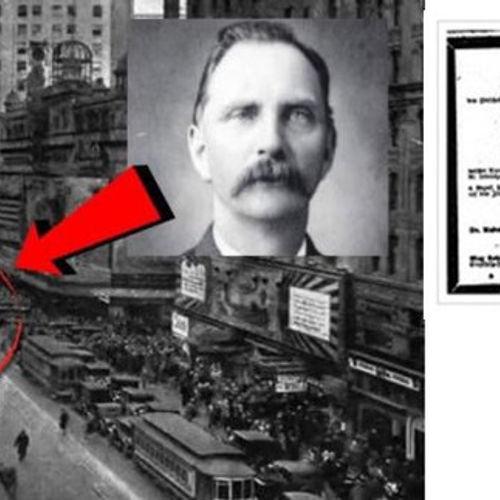
| Added | Mon, 16/10/2017 |
| Источники | |
| Феномены |
In this article, we consider the case of Rudolf Funcom already mentioned in the news.
The story of Rudolf Hentze has become one of the most famous urban legends of the 1970-ies and since then has repeatedly repeated. With the proliferation of the Internet in the 1990-ies it became increasingly referred to as the real fact and to be submitted as proof of the existence of time travel.
As a rule, the events in this story are described as follows:
One evening in mid-June 1951, at about 11:15 passers-by in times square noticed a man of about 20, dressed in the fashion of the late 19th century. No one saw where he came from. He looked confused and distracted, and clearly was disoriented, standing in the middle of the intersection.
Suddenly, this man drove a cab. He was mortally wounded and died before people could intervene.
The body of the ordinary citizen searched the morgue and found in his pockets following things:
- a copper token for a beer worth 5 cents, bearing the name of the salon, which was unknown even to the oldest inhabitants of this district;
- account about caring for a horse and the washing of carriages, issued from a stable on Lexington Avenue that did not exist at that time;
- about 70 dollars in old banknotes;
- business cards in the name of Rudolf Hentze with an address on Fifth Avenue;
- the letter sent to this address, in June 1876 from Philadelphia.
All these things wore out over the past 75 years and looks like new.
The case began to lead the captain of the police Department of new York, Hubert W. Rome division, missing persons. He found that the address on Fifth Avenue, indicated in the card, was not a dwelling house. It was a commercial firm, whose owner has never heard the name of Rudolf Hentze.
The name of Fentora was not specified in the address book, his fingerprints were not recorded, and no one reported that he was missing.
Rome continued the investigation and finally discovered Rudolf Hentze Jr. in the phone book 1939. Rome interviewed residents at the address and found out that once there lived Rudolf Fenz who worked nearby. After his retirement in 1940 he moved to another place.
The investigator managed to find a Florida widow Venza Jr., who, as it turned out, had died five years earlier. She said her father-in-law Rudolf Fentz disappeared in 1876 aged 29 years. Rome found in the archives of the photo Fence and the case file about his disappearance. The man in the photograph was identical to the deceased. Captain Rome, afraid to seem insane, has not released the results of its investigation in the official documents.
The interest in this story grew up after 1972, when she began to appear in thematic books and articles as proof of time travel. In 2000, in the Spanish magazine Más Allá was published a 6-page article about the incident "Regreso al futuro en el corazon de Manhattan" (Rus. "Back to the future in the heart of Manhattan") authored by Carlos Canales, who by that time had written two books on the research of paranormal phenomena and folklore.
This article is interested in the folklore researcher Chris Ober. He examined the magazines of the time and found that the story moved from country to country: from Swedish to Norwegian Arcanum Fakta in turn from him to the Italian Il Giornale dei Misteri, where I went next to Spain and France. Later he found that the beginning of this urban legend can be considered the publication of stories about Fence in the June issue of the journal "Frontier research journal" (Journal of Borderland Research) in 1972, which presented it as real. In turn, the article in this magazine referred to the book of Ralph of Holland's "A Voice from the Gallery" 1952. Ober found that it gave rise to the urban legend.
After 2001, Aubert published the results of their research in the Akron Beacon Journal, approached by a fan of science fiction George Murphy, who explained that the original source was older still.
The results showed that the urban legend arose from a short story written by Jack Finney in 1950 and first published under the title "I'm Scared" ("Fear..." in the translation by A. A. Bitov) "Molerovskogo weekly" of September 15, 1951 and then in 1952, included in the anthology of sci-Fi works under the direction of Robert A. Heinlein, "Tomorrow, The Stars".
Translated by «Yandex.Translator»
Log in or register to post comments
